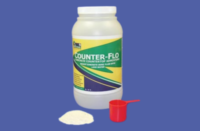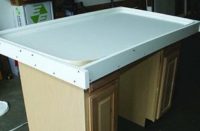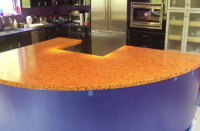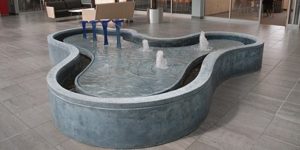Some 25 or more years ago, when my father would tell me he needed help making a rubber mold, he meant only one thing — using latex. Liquid rubbers for making production-quality molds have come a long way since then. Science has continued to perfect specialty compounds for mold-making. These compounds are designed to address the very specific challenges associated with very different mold applications, including architectural and decorative precasting.
In broadest terms, mold material comes in three varieties: latex, polyurethane and silicone. Each has its strong points and weaknesses, and choosing the right one for the job is the most important step in the process. Your choice should be driven by the answers to a few questions.
You should identify:
- What is the project schedule? How many pieces will I be casting?
- What casting material is to be used in the mold?
- What is the composition and level of detail of your master?
- Are there any special considerations?
With these parameters identified, you should be ready to select the best rubber material for the job.
Latex
Natural latex has been used in molds made for casting plaster and concrete since the mid-1940s. It is unrivaled in strength, flexibility and resilience. Latex rubber is applied by brushing many layers onto your master over an extended period of time. Application will start with thin coats at the beginning and shift to much heavier layers during finishing coats.
After the desired thickness is built up (an average mold will get 30-plus coats), the mold will be left three to four days to achieve its final cure. This step is known as “vulcanization,” and it is where the latex gains all its beneficial qualities. Vulcanized latex is unaffected by the heat generated during plaster and concrete cure. It reads and maintains fine detail very well, has a long life expectancy and provides the most bang for the buck. A latex mold can turn out hundreds of concrete casts over many years if treated well.
The drawbacks of latex are all issues of time and application. Latex molds require more time and attention and can take two weeks to complete. Liquid latex has an ammonia smell to it and should be used in a well-ventilated area.
Also, care must be taken when purchasing liquid latex. Lower-quality products may contain fillers that deaden flexibility and memory, and materials with low solids content can suffer excessive shrinkage. I have also seen bargain latex degrade rapidly from exposure to sunlight and certain release agents. Latex would not be used for a poured mold and will always need a rigid backer mold for casting.
I’ve only brushed on latex rubber. I understand it can be sprayed, but I prefer the control I get with a brush.
Polyurethane
Polyurethane mold rubbers represent about 90 percent of the synthetics I use. Polyurethanes are abundant, very versatile, and vary vastly in their physical properties.
One key fact about polyurethane rubbers is that they can be used to create poured molds, not just brushed or sprayed-on ones. Poured rubber molds are solid cubes or slabs that require a greater amount of rubber material but can be used for casting without the need for a supportive backer mold. They cure at room temperature and can be ready for use in as little as a few hours, though most are cured and ready the next day.
Polyurethanes come in different consistencies, and they can be thickened to address special circumstances in your mold creation process.
It’s also important for the polyurethane to be thixotropic, which for this discussion refers to the liquid’s ability to be brushed on yet stick and stay where you apply it. This is of great benefit when making a mold with horizontal overhangs or doing an on-site mold for duplication of a piece that cannot be brought back into your shop.
How polyurethane rubber is rated
Polyurethane rubbers are rated by hardness. A rubber with Shore A 20 hardness is soft, while one rated Shore D 45 is very firm. The firmness you want depends in part on the depth and type of details in the piece you will be casting. Deep voids and high-relief detail are delicate and need a soft rubber that will easily fold in on itself when pulled away from the cast face. Firm rubber being pulled from a piece with thin, unsupported details can damage them and ruin your cast.
Polyurethanes have great chemical resistance and are perfect for casting polyurethane, epoxy, and polyester resins.
However, polyurethane is not as hearty as latex and will wear out faster, especially around fine details and voids. Solvents will have a destructive effect on certain polyurethanes, and care must be taken with each type of polyurethane mold product when choosing cleaners and release agents. Some polyurethanes will not bond to themselves after an applied layer has cured, so care must be taken while applying them not to allow too much time to pass between coats, or delamination can occur. If polyurethane molds are stored with folds or wrinkles in the material or even slightly bent or curved they will likely hold those deformations long term.
Silicone
Silicone mold compounds are in most ways like polyurethane compounds. The different types vary greatly, they all cure reasonably quickly at room temperature, and they can be brushed on or poured.
Generally, silicones are softer and more chemically resistant than polyurethanes, making silicone a great choice for historic restoration and duplication as it reduces the chance of damaging the original piece being molded.
Silicone molds do not require any release agent when casting resins (including when “cold-casting” a resin mixed with metal powder) and need little more than a light mist of silicone release agent every other pour when casting plaster or concrete.
All that said, silicone compounds are generally reserved for situations where no alternative would do. To begin with, they are more expensive than comparable polyurethanes. They are very finicky, so mix ratios and weights have to be precise. Silicone rubbers cannot be used over plastilina (sulfur-based sculpting clay) or other materials that could be cure inhibitors. Silicones utilizing a tin-based catalyst are known to shrink slightly in the curing process.
To bring this article back to the beginning, selecting the correct mold-making material is just as important as learning how to correctly mix and apply it.
If there is a variable in your project you are unsure of, try calling the tech wizards at your rubber distributor. They are a vast and friendly resource that I use frequently.
















